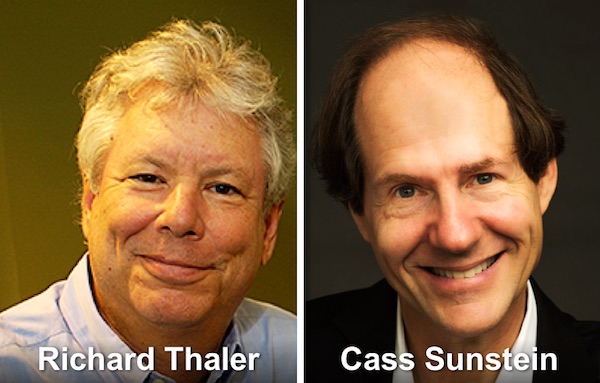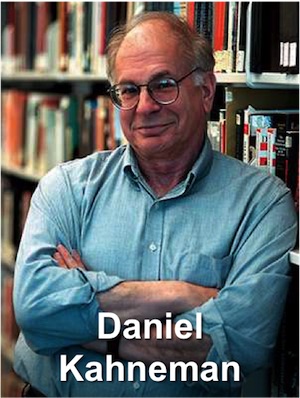Arguably, behavioural economics is Richard Thaler’s baby. And an important baby it is too, being part of an essential late twentieth century trend. At last, economists – spurred on by psychologists and social scientists, stopped seeing people as ‘rational units of intelligent decision making’ and started seeing us as part rational and part irrational bundles of ideas, knowledge, feelings, desires and biases.
It is with these filters, rather than pure rationality, that we make decisions. And that insight was an essential correction to classical economics. It won the psychologist, Daniel Kahneman, a Nobel Prize in economics. His collaborator and mentee, economist Richard Thaler, then led the development of the ideas.
Writing with University of Chicago colleague, Cass Sunstein, they together produced the massive selling book, Nudge. But why is co-authorship enough to justify Sunstein’s place in a management thinker pair, when Thaler led the charge on behavioural economics? The answer lies in Sunstein’s contribution: he’s a constitutional and administrative lawyer with a strong interest in social policy. His thinking helped bring behavioural insights out of the classroom, ad agency, and boardroom, and into public policy.
It’s not just in the supermarket that we get nudged to buy stuff, but when we interact with Government too. And between them, Thaler and Sunstein’s conception of liberal paternalism inspired a number of benign behaviour changes, with no whiff of compulsion. Their ideas were picked up by governments all over the world, including the US, where Sunstein (a former colleague) served in Barack Obama’s administration, and here in the UK, where Prime Minister David Cameron established a Nudge Unit within Government.

Richard Thaler
Richard Thaler was born in 1945 in New Jersey. He studied at Case Western Reserve University, gaining his BA in 1967. From there, he went to the University of Rochester, for his MA (1970) and PhD (1974).
In his PhD, Thaler started the work that still occupies him today, investigating the economic value of a life. What he found was a huge disparity in people’s evaluation of the worth of one week of their life. When asked to put a value on a week lost, or on a week gained, people needed a high payment to be prepared to give up a week of life. Yet they would be prepared to pay far less to gain an extra week.
This imbalance is, of course, irrational. And that interested psychologists Daniel Kahneman and Amos Tversky. They researched all sorts of biases and shortcuts in our thinking. Thaler became a long term collaborator with the pair.
Thaler stayed in the academic world, holding teaching and research positions at many institutions. His permanent academic homes were the Universities of Rochester (1974-8), Cornell (1978-95) and then Chicago, from 1995 to the present day. It was at Chicago that Thaler met Cass Sunstein.
Cass Sunstein
Cass Sunstein was born in Massachusetts, in 1954. He gained his BA at Harvard College in 1975 and his JD from Harvard law School in 1978. Before returning to academia, Sunstein clerked for justices in the Massachusetts and US Supreme Courts, and served in the Justice department from 1980-1981.
In 1981, he became an Assistant Professor at the University of Chicago, becoming a full Professor in 1985. He remained at Chicago until 2008, when he formally moved to a post at Harvard Law School. However, having become friends with another Chicago Law School professor, Barack Obama, he headed up the Whitehouse Office of Information and Regulatory Affairs from 2009 to 2012.
Behavioural Economics
In 2008, after working together on the ideas in the book for five years, and having known each other for ten, Thaler and Sunstein published a best-selling book, Nudge: Improving Decisions About Health, Wealth and Happiness. This brought the ideas of behavioural economics to a wide audience, and introduced many of us to the term ‘choice architecture’.
Choice Architecture
Choice architecture is a beautifully simple idea. By framing choices in a certain way, we can make it easier – physically, cognitively, psychologically – for people to make one choice rather than another. It’s how supermarkets channel customers and how governments secure compliance.
Choice architects study the heuristics people use to make decisions. These are the mental shortcuts we apply, that save us from having to think too carefully, expend too much effort, and take time over mundane choices. Except these heuristics effectively hard-wire biases into the way we make decisions. These are the biases that choice architects can exploit.
Nudges
A ‘Nudge’ is simply a selection of how to frame (or architect) a choice, so that people can more easily make a choice that will satisfy them. Setting up nudges that satisfy you, at the cost of the chooser is manipulation. If you can avoid forcing your outcomes upon anyone, but make it easy for them to make a choice that suits them, Thaler and Sunstein refer to this as ‘libertarian paternalism’.
The tools that choice architects use are:
- Setting the right defaults, so the easy choice is the best one
- Anticipating errors, and therefore making correct behaviour easier
- Setting up complex choices to highlight the right ones
- Creating positive incentives for beneficial behaviour
The Behavioural Economics Context
Choice architecture is a subset of behavioural economics. This is the study of how real humans (not the artificial idealised, wholly-rational ‘econs’ of earlier economic theory) behave. Given economic choices, we are not wholly rational. This distorts markets and creates dynamics that do not conform to rational economic theory. This may seem like an obvious observation, but to economists through most of the twentieth century, it was not obvious at all. Year after year, new models and theories worn prestigious prizes. All were based on the myth of the ‘rational actor’.
Now, we know for sure that this rational actor is an ideal at best and a mythical creature at worst, we can start to do messier, but more realistic economics. That’s behavioural economics or, as Richard Thaler points out, Behavioral Economics: ‘why do the British need a superfluous u?‘, he asks. Because we are not rational, I suppose.
Richard Thaler on Nudge
A lot of great content, though edited with some disconcerting cuts.

